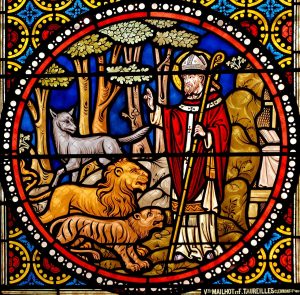
Divine Beauty and Harmonious Joy
Let’s work into this topic slowly. I begin by making three basic claims.
- First, beauty is a kind of value. Thus, the discipline of philosophy that studies beauty is called aesthetics, and that is a sub-discipline of the study of value or axiology. When it comes to beauty, we can understand it, as the philosopher Matthew Baddorf describes as “the most exalted kind of aesthetic state.”[1]
- Second, God is beautiful. To say God is beautiful to say that God, the divine substance has or possess a certain attribute or property, the property of being beautiful. And of course, God will have this property to the maximal degree, if there is a maximal degree to beauty. There is of course a rich tradition of ascribing beauty to God.
- Third, God is beauty itself. How might be understand this? If we think of axiological goodness as a kind of excellence and God’s aesthetic excellences as being maximally or pre-eminently beautiful, then it is proper to say that God is beauty itself in this sense: “God just is the exemplar of aesthetic excellence.” So, when we say things like God is goodness itself, or beauty itself, or being itself, we are just saying God is the exemplar of excellence when it comes to the kind of value we have in view. So, in sum:
Beauty is a value. God is beautiful. God is beauty itself.
How, exactly, is God beautiful?
Here is a view I find plausible, defended recently by the philosopher Matthew Baddorf in his essay on divine simplicity and divine beauty. His basic idea is that beautiful things are beautiful because they enjoy a kind of harmony between all of the thing’s parts. This view is dubbed by Baddorf as structuralism. Here is his description of structuralism:
“Stucturalism: If an object is beautiful, it has a kind of unity, proportion, harmony, or some similar relation of various elements as a whole.”[3]
But then, this entails that God, as beautiful, has structure. God has parts. These parts, of course are not physical parts, but they could be understood as metaphysical parts. What kinds of parts could these be? Here are some candidate metaphysical parts had by God: properties, thoughts, ideas, persons (on one way of understanding the Trinity), and relations between these parts. There are also parts of the soul or agent such as an intellect and a will.
God is not simple (this is a main point of Baddorf’s essay). Rather God is necessarily a divine unity.
Does structuralism suffice to capture divine beauty, in your view, or does something need to be added in your view?
I’m not totally sure, but I worry that something is missing if we simply equate divine beauty to the structure of the various elements within the divine substance. To see why, consider that there are various kinds of beauty. One taxonomy, as noted by the philosopher Peter Forrest, is to distinguish between static and dynamic beauty.[4] Given this distinction, one worry is that while structuralism does a great job capturing the static or “at a time” beauty of God, it leaves out the dynamic or “over time” beauty of the divine life. God is beautiful in all the ways that things can be beautiful and as an agent, we want to include dynamic beauty with respect to God’s inter-trinitarian relating (as C. S. Lewis and others refer to suggestively as a kind of divine dance) and also with respect to God’s action in the world (which can be described as the unfolding of the divine drama, the beautiful story of God). So, perhaps we can build on Baddorf’s suggestion and provide an account of divine beauty in terms of what we might call agential structuralism. The view then could be something like this:
Agential Stucturalism: If an object of the kind, agent, is beautiful, then it has a kind of unity, proportion, harmony, or some similar relation of various elements and acts as a whole.
Why does it matter to me that God is beautiful?
Let’s end by making some connections between the harmony of beauty and joy. In the Summa Theologiae, Aquinas provides an account of beautiful things consistent with our account here of beauty in terms of agential structuralism. He says
“For beauty includes three conditions, integrity or perfection, since those things which are impaired are by the very fact ugly; due proportion or harmony; and lastly, brightness or clarity, whence things are called beautiful which have a bright color.” Aquinas, Summa Theologiae 1.39.8
As we close, I want to reflect on these three “harmony relations” and summarize how these make a difference to you and me as described by Barbara Nicolosi in the book For the Beauty of the Church.[5] Nicolosi notes that
- Wholeness (integrity/perfection) = nothing is missing; nothing is extra; wholeness creates in us a sense of rest (all is well; all is at it should be).
- Harmony (proportion) = every part brings out the best in all the other parts; harmony creates in us a sense of joy (because we were created to dwell in community)
- Radiance (brightness/clarity) = beautiful objects communicate something profound to us; our encounter with beauty feels like a personal communication.
Thus, beauty, understood theologically, reminds us of God, points us to God, and invites us to enter into the divine life and in doing so to find joy.
Instagram: mere.creativity
Web: merecreativity.org
[1] Matthew Baddorf, “An Argument from Divine Beauty Against Divine Simplicity,” Topoi 36 (2017): 658.
[3] Baddorf, “An Argument from Divine Beauty Against Divine Simplicity,” 659.
[4] Peter Forrest, “God and Perfect Beauty,” in Ontology of Divinity, ed. Miroslaw Szatkowksi (De Gruyter, 2024).
[5] Barbara Nicolosi, “The Artist,” in For the Beauty of the Church, ed. W. David O. Taylor (Grand Rapids, MI: Baker, 2010), 106–109.




